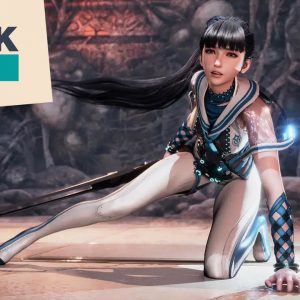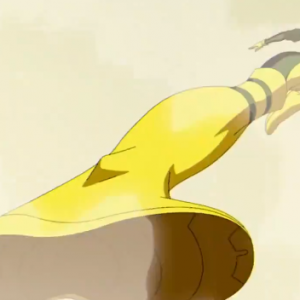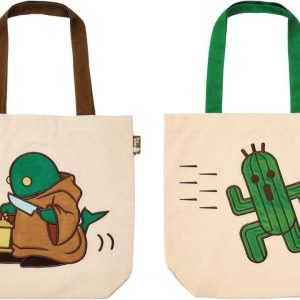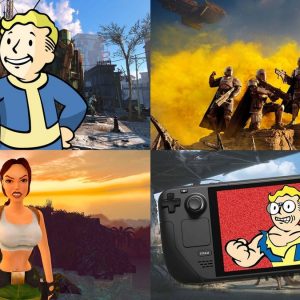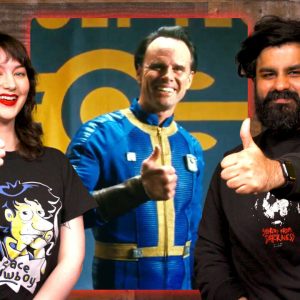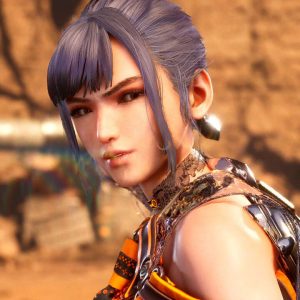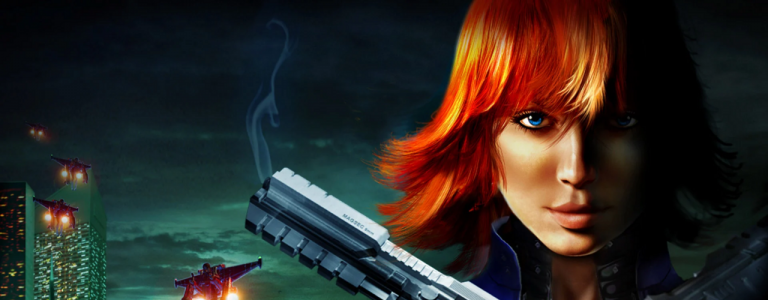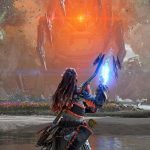I keep wanting to love Atlas Fallen. I mean, it’s a delightful Prince of Persia-inspired open-world action RPG with big ideas, big monsters, and even bigger weapons to fight them with, so it’s got that going for it. And I did enjoy myself as I explored each of its four unique zones, which stretch as far as the eye can see and deliver some mouthwatering, if kinda washed out, vistas. After spending about 18 hours with its mix of respectable monster slaying and brisk platforming, I can comfortably say it’s a good time – especially if you bring a friend into its seamless drop-in co-op. At the same time, its C-tier story is so campy and bone-dry – in both writing and character performance – that it’s clear Atlas has fallen a notch or two.
The middling story, which centers around a generic clash between a human rebellion and a tyrannical regime, starts out rough. No, there are relatively few bugs and the opening is pretty short – I mean, like, physically rough for my custom avatar, a rugged yet scholarly desert dweller. After a few introductory conversations with other desert dwellers in the first area, it was promptly implied that he’d been blasted in the face with a whole bunch of sand and left for dead before the opening cutscene, which kinda sucks considering his indentured servitude as one of the Unnamed. That’s the bottom caste of Atlas Fallen’s sand-strewn medieval world – which, as we learn through some apocalyptic mumbo jumbo narration – is ruled by an evil sun god named Thelos and ravaged by giant sand monsters called wraiths.
This is a pretty cool setup, but the execution of the plot that follows is thinner than the middle of an hourglass. For example, poorly synced lip movements and unenthusiastic voice acting sap the life out of cutscenes. On top of that, there’s no action in any of them, so they’re pretty dull – and each of Atlas’ major characters is a cardboard cutout with no personality to speak of. You’ve got the generic thief with the heart of gold, the upstanding knight girl who introduces herself by punching said golden-hearted thief in the face (but secretly has a soft spot the whole time,) and Nyaal, the other sun god. He spends his waking hours talking at you while looking like a knockoff of Jake Sully from Avatar, but more importantly, he inhabits the magical gauntlet at the center of the story which gives you your powers and a new hope for the rebellion against Thelos and his imperialist thugs. Unfortunately, this sun god is always there with you and rarely shuts up.
Luckily, if you can ignore all that, it’s relatively easy to see Atlas Fallen’s joy as an online co-op adventure where you and a friend run around a sprawling open world battling monsters. It’s a well-crafted map, with plenty of opportunity to unearth rare treasures, build up powerful characters, fight big monsters, do a little platforming – or just chill out and collect cosmetics for the excellent transmogrification system to your heart’s content. It balances simplicity and depth so expertly that it’s easily one of the best games to share between two online friends since It Takes Two.
That’s especially true when you get into the rhythm of the open questing system: this game lets you complete side-quests and interstitials between major story events separately while enjoying the same rewards – even when you’re across the world from one another. Given just how many main story quests scatter you to the wind in search of hidden gauntlet pieces, it’s fantastic to be able to freely split up and cover more ground – who knows, your friend might find something you missed instead of making you run around in circles or backtrack by yourself. That said, it’s a missed opportunity that couch co-op is nowhere to be found, and it’s thoroughly disappointing there’s no cross-play to let you and your buddies on other platforms team up.
It’s clear that the main quest is paced around unlocking new mechanics rather than telling a good story. Atlas Fallen spreads its story across four open-world maps, such as the underground fortress of Bastengar and the crater-filled Wildlands, each of which carries a distinct vibe and is packed with enough hidden treasure and decently rewarding side-quests to feel like there’s always something new to find.
Fetch quests make up the bulk of it, with Nyaal frequently asking you to “find three shards” to complete the latest relic and achieve the next major gauntlet upgrade. But I didn’t feel like I needed to work overly hard to find each of the scattered components, and the rewards were always worthwhile. For instance, unlocking the triple air dash was a game-changer that let me reach distant ledges, and Reveal lets you manipulate ancient artifacts that reveal hidden platforming challenges you didn’t even know were there.
Both of these new abilities unlock previously inaccessible areas, giving all four zones extra room to breathe and slowly unravel themselves to those willing to backtrack. But Atlas Fallen doesn’t power-gate its best loot behind that kind of repeated searching, meaning you can choose to only do the main story, skip all that extra spelunking, and comfortably beat the rather underwhelming final boss without the added trouble.
That said, the one thing you can’t skip is sand. Your weapons are made of sand, you move around quickly by surfing across sand dunes, and each of the various monsters is literally made of sand. The only things not made of sand are the many anvils found dotted across the world of Atlas Fallen, which serve as places to save your game, upgrade your armor, and fast-travel to other anvils.
Still, that’s a lot of sand in one land, let alone to conjure out of one hand – but there’s enough variety within this concept to not feel overly repetitive. Boss fights, quests, and random finds often give way to useful loot, armor, and Essence Stones that contribute to the deep customization and combat systems. Granted, many of these finds are cosmetic or simply merchant fodder with some bits of lore attached, but all the rare crafting items and Essence Dust (basically, Atlas’ version of experience points) make all that treasure-hunting feel worthwhile, even when there isn’t another powerful Essence Stone or armor piece around the next corner.
Meanwhile, power climb feels steady from start to finish – making combat encounters balanced as you venture into higher level zones, without making you grind for it – as long as you’re upgrading your armor, perks, Idols, Essence Stones, and Momentum Gauge at an anvil every so often. Those all help with a different aspect of character customization, but the main driver is your armor, which determines your character’s level and most of your combat stats like how much damage your attacks deal and how quickly your health can regenerate mid-combat.
Speaking of combat, Atlas Fallen’s action-packed battles are simple but highly dynamic, thanks to a small number of moves that grow in power as you land hits. Fights center around two basic attacks that work differently based on the weapon you assign them to, but the twist is that your character’s movement style changes depending on which weapon you strike with. For instance, the sword-like Sandwhip homes in on an enemy from a distance before pushing you backward, letting you whip around the enemy mid-air if you dodge around mid-combo like Sora from Kingdom Hearts. Alternatively, the punchy Knuckledust lunges you forward as you pulverize your opponents with both hands. There are three of these, and they all encourage very different styles.
Atlas Fallen also includes a deeply satisfying parry button, offering a generous window to counter enemy attacks, and a perfectly timed parry can turn the tides of any battle by freezing opponents. There’s also a two-handed slam attack that combines the styles of both equipped weapons, and you can top a chain of attacks off with an extremely powerful finishing move. That’s plenty to keep anyone busy in a typical encounter against a group of two or three large enemies like the marauding Tailguarder and the giant crab-like Shellbasher. And it’s a lot of fun to bring these bigger foes down piece by piece – it reminds me of hunting Rathalos across a vast desert in Monster Hunter.
I’m delighted at how Atlas keeps a nice balance between its moment-to-moment smashing and slashing and its resource management systems. This is thanks to the Momentum Gauge, which fills up as you land direct hits and successful parries against enemies, gradually unlocking abilities you’ve slotted along the gauge. These collectable abilities make up the meat of Atlas Fallen’s customization, and they can be crafted, upgraded, and mixed and matched to build any sort of character you’d want – including healers, damage dealers, crowd controllers, tanks, you name it. One of my favorite Essence Stones is the Evasive Burst, which creates a shockwave after every dodge roll or air dash while active. This let me deal incredible amounts of damage while whipping around airborne foes with the Sandwhip.
The catch is that it can be difficult to maintain high momentum since you receive more damage as your gauge reaches its limit. This risk and reward element keeps things interesting, since the strongest abilities sit on the upper end of the gauge, and it’s always tempting to unleash your highly gratifying finishing move to deal heavy damage at the cost of reducing your gauge to zero. It all comes together toward the end of the campaign, where every other fight has several enemy types filling the screen with lighting effects and clouds of yellowy dust – it’s kind of like the heavier moments of Doom Eternal, but with sand instead of viscera.
I’ve developed what I can best describe as a “love-hate” relationship with Atlas Fallen’s visual style. I’d often be wowed at how gorgeous some of its zones look – some of it made me feel as if I were standing inside a piece of elegant concept art. Especially once I’d unlocked my favorite suit of armor: Red Company, a suit that gleams brilliantly in direct sunlight as tufts of fabric unfurl around it. That looks fantastic on its own, but even better once I’ve dyed it with gold and blue dye I purchased from a traveling merchant.
I’m also pleased that Atlas Fallen produces consistently high frames in the PS5’s Performance mode, but I’m not as impressed that it struggles with its fidelity even in Graphics mode – which is a shame because of how pretty and detailed its zones and armor designs are. Many of its animations are clunky, but what really bothers me is the compressed textures, low-quality models, and graininess that look flat-out ugly on my PS5 in both visual modes, as if I were playing a poorly made port of a Nintendo Switch game. Atlas looks much clearer on PC with none of the aforementioned compression issues, but its character models still evoke the uncanny valley more than most games.

